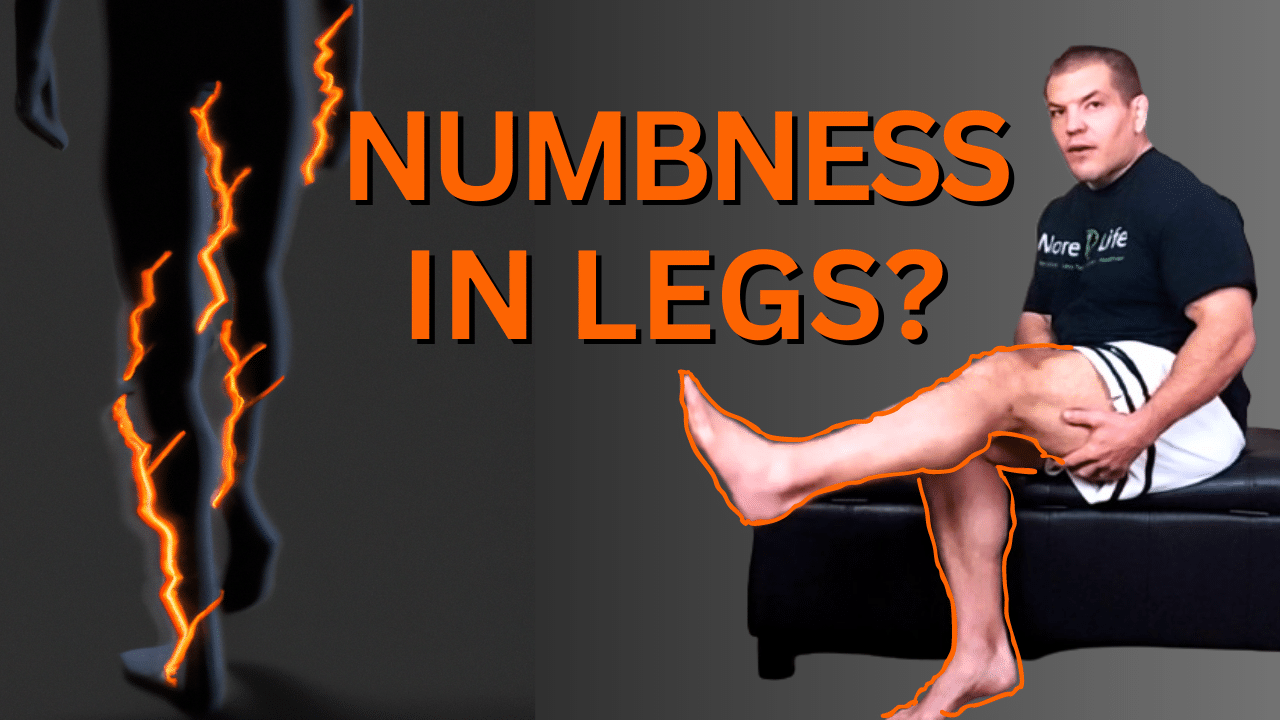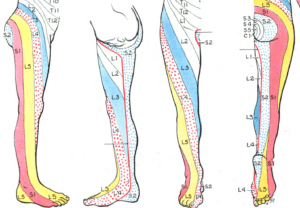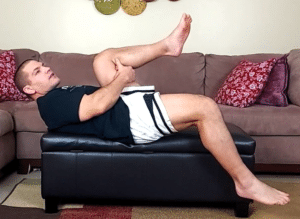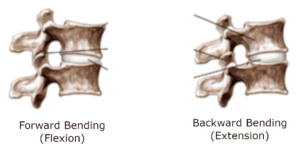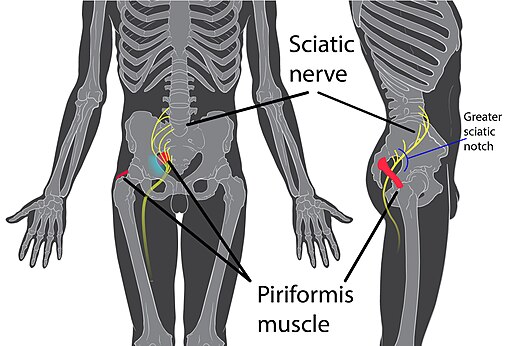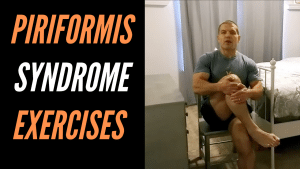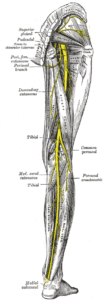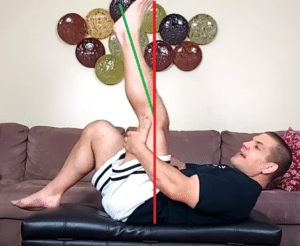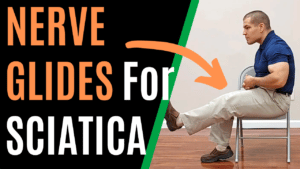If you have numbness in your legs, it's natural to wonder what causes it, and how you can get it to go away. Numbness in the legs can come from several different causes, but most of them aren't serious and are completely reversible.
Watch the video to learn the most common causes of numbness in the legs and treatment for them.

Table of Contents
- 3 Categories of Numbness in Legs Causes
- Numbness in Legs Caused by Lower Back
- Numbness in Front of Thigh (Femoral Nerve)
- Numbness in Legs Caused by Lower Back and Piriformis Syndrome
- Numbness in Legs from Sciatica / Hamstrings
- Cause of Numbness in Lower Legs and Treatments
- Other Treatments for Numbness in Legs
3 Categories of Numbness in Legs Causes
There are generally three different categories of numbness legs causes. Those categories include:
1. Primary nervous system disorders
A stroke (CVA), multiple sclerosis, or a spinal cord injury are example from this category.
These are cases where there's an injury or damage to the nervous system itself. Sometimes those are reversible (such as with a mini-stroke or TIA).
However, sometimes there are lasting symptoms, such as the case of like multiple sclerosis or a spinal cord injury.
The good news is that's fairly rare in comparison to the number of people who have numbness in their legs. That's only a very small percentage, and usually, if you have one of those things, it's most likely already know it.
If you're reading a blog post to try to figure out the causes of numbness in your legs, then chances are fairly decent that it may not be one of those problems.
2. Metabolic disorders
In this case, there's a problem in some other body system that's making your nerves unhealthy. Examples of this might be diabetic neuropathy, where your blood sugar gets too high and it impairs the circulation and nutrition of your nerves. Other examples include a vitamin deficiency, liver damage, or peripheral artery disease. All of these things can cause numbness in your legs.
3. Nerve Compression
The third and least severe category (but most common) cause of numbness in the legs is nerve compression.
That nerve compression can come from various places:
It can come from your lower back, which is probably the most common.
It can also come from peripheral nerve compression in the hip or leg. We'll get into a bit more detail on that later in this post.
You should also keep in mind that compression of your spinal cord in your neck can cause numbness in both your legs and arms. So if you have this, I'd suggest checking out my post on Cervical Spinal Stenosis.
Numbness in Legs Caused by Lower Back Problems
Lower back problems are the most common cause of numbness in the legs. The nerves that go to your legs all come from your lower back.
These nerve roots that emerge from the L1, L2, L3, L4, L5, S1, and S2 levels.
The nerves may get compressed for various reasons such as bulging, herniated, or degenerative discs.
Other conditions such as lumbar spinal stenosis, can also cause numbness in the legs.
However, regardless of the structural cause, knowing the location of the numbness can give you an idea of what spinal level the problem is coming from.
This is important to know because MRI's don't always correlate with clinical findings.
For example, if you have numbness in the front of your thigh and your MRI shows a herniated disc at L5-S1, it's unlikely that the herniated disc is the cause of your thigh numbness.
Why is that?
Because the L5 and S1 nerve roots don't supply the front or your thigh.
And the last thing that you'd want is to have a surgery to fix your herniated disc and then wake up and still have the numbness in your thigh, plus the pain from the back surgery.
So what nerves DO cause numbness in the front of the thigh?
Numbness in Front of Thigh (Femoral Nerve)
The upper nerves, specifically L2, L3, and L4, form the femoral nerve, which runs down the front of the legs.
The L2, L3, or L4 nerve roots can get compressed in your lower back.
However, you can also get compression of the femoral nerve can occur below the lower back, such as in the inguinal canal.
Stiff hip flexors or quadriceps can put pressure on the femoral nerve, so it is important to determine if the compression is spinal or peripheral.
Movement tests, such as bending forward or backward, can help distinguish the source of the numbness.
If the numbness changes (better or worse) just by changing the position of your spine, that's an indication that it may be coming from your lower back. If spinal movement or position doesn't affect the numbness, the cause may be elsewhere.
To assess hip flexor flexibility, lie down and let the affected leg fall while pulling the other leg up.
If the leg can fall all the way down to the bed with the knee bending to 90 degrees, that's a normal test.
Stiffness in the hip flexors or the quadriceps can potentially compression of the femoral nerve.
However, hip flexor tightness can also lead to a forward pelvic tilt and increased spinal extension. As you can see from the image below, spinal extension narrows the spaces where the nerve roots exit the spine, particularly if you have degenerative disc disease.
Consulting a physical therapist experienced in treating spinal conditions can help you figure out the cause of your leg numbness
Numbness in Legs Caused by Lower Back and Piriformis Syndrome
Another common issue related to numbness in the legs is sciatica, characterized by numbness in the back of the leg and often accompanied by pain.
Sciatica can result from compression of the sciatic nerve or its nerve roots, including L4, L5, S1, and S2.
However, it can also come from piriformis syndrome, compression of the sciatic nerve at the pelvis.
The piriformis is one of 6 hip external rotators. The sciatic nerve runs underneath of the piriformis, and in 10-20% of the population, the sciatic nerve actually runs through the piriformis.
These are the people who are probably at highest risk for developing a true piriformis syndrome.
However, it's far more likely that your sciatica is coming from your lower back.
So how do you tell if numbness in the back of your leg is coming from your back or from piriformis syndrome?
As mentioned above, if changing the position of your spine without moving your hip affects your symptoms, that might indicate the problem is coming from your lower back.
If the numbness is coming from piriformis syndrome, sitting on a hard surface may increase your symptoms because the hard surface puts more compression on the sciatica nerve.
However, people who have a lower back problem sometimes feel better sitting on firm chairs that offer more lower back support.
So how do you treat leg numbness caused by piriformis syndrome?
People who have a compression of their sciatic nerve at the pelvis will often try to stretch their piriformis.
But stretching your piriformis isn't necessarily always the greatest idea.
Sometimes piriformis syndrome can be caused by a piriformis that's too stiff and needs to be stretched.
But other times, it's actually caused by that muscle being chronically overlengthened.
Therefore, further stretching out that muscle isn't going to help. It might even make the problem worse.
Learn how to determine whether or not you NEED to stretch your piriformis, and HOW to do it in this post.
Numbness in Legs from Sciatica / Hamstrings
Compression of the sciatic nerve can also occur in the hamstrings.
It seems like most people thing they have tight hamstrings, even if they don't.
An irritated sciatica nerve can make the back of your leg feel stiff or tight, even if your hamstrings aren't truly short.
But overstretching your hamstrings may be bad for sciatica, because nerves aren't made to stretch.
So how do you know if you need stretch your hamstrings?
You can test your hamstring flexibility by lying on the back, bringing the hip up to 90 degrees, and straightening your knee.
If your lower leg can get within 10 degrees of vertical, that's a normal test.
You don't want to stretch your hamstrings unless they're truly stiff or short.
A better option might be using a massage stick on your hamstrings to loosen up the muscles around the sciatic nerve without overstretching the nerve itself.
Massage Stick 18" Flexible Handheld Spin...
$33.95 ($33.95 / Count) (as of April 25, 2024 10:48 GMT -05:00 - More infoProduct prices and availability are accurate as of the date/time indicated and are subject to change. Any price and availability information displayed on [relevant Amazon Site(s), as applicable] at the time of purchase will apply to the purchase of this product.)Sciatic nerve glides are another good exercise, but you should not have an increase in pain, numbness, or tingling in your legs when doing these.
Cause of Numbness in Lower Legs and Treatments
When numbness extends into the lower leg and foot, differentiating between nerve root compression in the lower back and peripheral compression is essential.
This is particularly important if you have numbness in your lower leg and foot that skips the thigh.
In this case you may still have a back problem but it's a good idea to check for a peripheral nerve compression as well.
Your sciatic nerve splits into two branches just above the knee: the tibial branch and the fibular (peroneal) branch.
Common Fibular Nerve Compression
The common fibular nerve run along back outside your knee.
It then splits into two branches:
A superficial branch which supplies the outer leg and outside of your foot, and a deep branch that supplies the top of your foot.
The common fibular nerve can get trapped behind the fibular head, which is the bump on the outer side of your leg just below the knee.
There are two self-mobilization exercises that can help with this kind of problem.
Tibiofemoral Mobilization
Sit with the numb leg crossed over the other like a figure 4.
Pull the lower leg toward you with one hand while pushing the thigh away from you. Hold for 1 minute.
Proximal Tibiofibular Mobilization
Put your foot up on a chair, couch, or ottoman.
Put the meaty part of your palm behind the fibular head of the affected leg.
Lean forward allowing your knee to bend while pushing forward using your palm.
Repeat for 1 minute.
Stretching your calves
In many cases, stretching your calves can be helpful for numbness in the lower legs. However, many people do calf stretches incorrectly.
Learn how to do calf stretches properly.
Using a massage stick on your calves just like you were using it on your hamstrings can also be helpful.
Make sure to roll the back, outside, and inside of the calves to get to all of the different heads of the calf muscles.
Other Treatments for Numbness in Legs
Nerves need space, movement, and blood flow to be healthy. After rolling and stretching your muscles (to make sure they have space to move), doing nerve glides as previously mentioned can be helpful.
Nerve glides create movement and blood flow to your nerves.
Aerobic exercise is another great for almost all causes of numbness in your leg.
Whether it is peripheral artery disease, diabetes, or a compressed nerve, aerobic exercises like walking help increase blood flow.
Aerobic exercise also helps keep your blood sugar down in the case of diabetes.
Additionally, if you have a problem with your spinal discs, when you walk, that upwards and downwards compression of your spine helps circulate nutrition to the discs to help them heal.
So, walking is a great exercise for most causes of numbness in your legs.
Conclusion
Hopefully you found this post helpful to get a little more clarity about the various causes of numbness in your leg.
As you've read, there are many different causes and it can be overwhelming, sometimes even to healthcare providers.
Fortunately, our specialist physical therapists here at More 4 Life are experienced in treating patients with numbness in their legs. We can help you identify the causes of the numbness, as well as what things you can do to relieve it.
If you need help for numbness in your legs, just tap the button below to request an appointment with one of our specialists.
Like this post? Here are a few others you might enjoy.
Spinal Stenosis And Walking Problems
Numbness In Fingers? 6 Causes of Tingling In Hands

